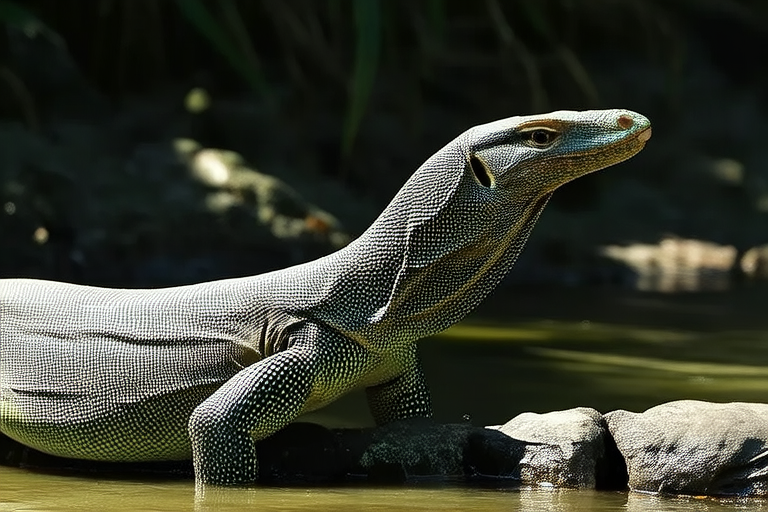Adventures with a Water Monitor: Tips for First-Time Owners
Welcome to the world of water monitor lizards! These fascinating reptiles can make rewarding pets for those who are prepared for the commitment and challenges they present. Before diving into the details of care, it’s important to understand that owning a water monitor is a significant responsibility. This article will guide you through setting up a suitable enclosure, understanding their dietary needs, and addressing common health issues.
Understanding Your New Pet
Water monitors (Varanus salvator) are one of the largest lizard species in the world, native to Southeast Asia. They are highly intelligent and active creatures that require a lot of space, stimulation, and proper care. As a first-time owner, it’s crucial to be well-informed about their natural habitat and behavior to ensure they thrive in captivity.
Habitat Needs
Creating a suitable habitat is the cornerstone of water monitor care. Monitors need a large enclosure that mimics their natural environment, providing ample space for swimming, climbing, and basking. A minimum tank size of 12 feet by 6 feet by 6 feet is recommended for adult monitors. The enclosure should include:
- Water Area: A deep water section where your monitor can swim comfortably. Ensure the water is clean and changed regularly.
- Land Area: A dry area with branches, rocks, and logs for climbing and hiding.
- Basking Spot: A heat lamp or ceramic heater to provide a warm spot for thermoregulation.
Maintaining hygiene within the enclosure is vital. Regular cleaning of the water area and substrate helps prevent bacterial growth and keeps your monitor healthy. Use a high-quality substrate that retains moisture but doesn’t become moldy.
Dietary Requirements
Water monitors are carnivorous and require a varied diet to stay healthy. Their meals should consist of:
- Insects: Crickets, mealworms, and superworms can be offered as occasional treats.
- Small Mammals: Pinkie mice or small rodents can be fed once or twice a week.
- Fish: Freshwater fish can be provided as part of their diet.
- Supplements: Calcium and vitamin D3 supplements are necessary to prevent metabolic bone disease.
Feeding should be done in a separate container to avoid substrate ingestion and contamination. Always supervise feeding sessions to prevent overeating or aggressive feeding behaviors.
Handling Tips
Water monitors are powerful animals capable of inflicting serious injuries. Handling should be done carefully and only when necessary. Always approach your monitor from the side, never directly from above, to avoid startling it. Use a sturdy, long-handled hook to gently coax your monitor out of its enclosure if needed.
It’s essential to build trust with your monitor over time. Frequent, gentle interactions can help your monitor become more comfortable around humans. However, remember that even well-socialized monitors may exhibit defensive behavior if they feel threatened.
Common Health Issues
Like all pets, water monitors can experience health problems. Some common issues include:
- Metabolic Bone Disease: Caused by calcium deficiency, leading to weakened bones and fractures. Regular supplementation and UVB lighting can help prevent this condition.
- Respiratory Infections: Often due to improper temperature gradients or poor hygiene. Symptoms include nasal discharge and lethargy.
- Parasites: Internal parasites can cause weight loss and poor appetite. Regular fecal checks and deworming are essential.
If you notice any signs of illness, consult a veterinarian specializing in reptiles immediately.
The Unique Challenges and Rewards
Owning a water monitor comes with unique challenges. These lizards are incredibly strong and can be destructive if not given enough space and mental stimulation. However, the rewards of having such an intelligent and engaging companion far outweigh the challenges.
Monitors are highly curious and can learn to recognize their owners. They can also be trained to perform simple tasks, making them a fascinating addition to any household. Despite their wild nature, many monitors form bonds with their keepers, offering a unique connection between human and animal.
Setting Up a Suitable Enclosure
When setting up your monitor’s enclosure, consider the following:
- Size: As mentioned earlier, a large enclosure is essential for the monitor’s physical and psychological well-being.
- Temperature: Maintain a gradient of temperatures within the enclosure, with a hot spot around 95°F and cooler areas for thermoregulation.
- Humidity: Monitors need a humid environment, typically between 70% and 80%. Mist the enclosure daily to maintain humidity levels.
Regular maintenance is key to keeping your monitor’s enclosure safe and healthy. Clean the enclosure at least once a week, replacing soiled substrate and cleaning any accessories. This helps prevent the buildup of harmful bacteria and ensures your monitor remains happy and healthy.
Maintaining Hygiene and Safety
Hygiene is paramount when caring for a water monitor. Regularly clean the water area to prevent algae growth and maintain water quality. Use a high-quality water filter to keep the water clean and fresh.
Safety for both the monitor and its human companions is also crucial. Always handle your monitor with care, using appropriate tools and techniques. Keep the enclosure secure to prevent escapes and potential accidents. Regular veterinary check-ups can help identify and address any health issues early on.
Encouraging Responsible Pet Ownership
Owning a water monitor is a significant commitment that requires dedication and responsibility. Before bringing a monitor home, ensure you have the resources and knowledge to provide proper care. Research extensively, consult experienced owners and veterinarians, and prepare adequately for the long-term commitment.
Responsible pet ownership means providing your monitor with the best possible care, respecting its needs, and being prepared for the challenges that come with owning such a unique and powerful animal. By doing so, you can enjoy a rewarding relationship with your water monitor and contribute to its overall well-being.
Conclusion
Adventures with a water monitor can be incredibly rewarding for those willing to take on the challenge. With the right setup, care, and attention, these magnificent creatures can thrive in captivity. Remember, owning a water monitor is a lifelong commitment that requires dedication, knowledge, and a genuine love for these fascinating reptiles.
